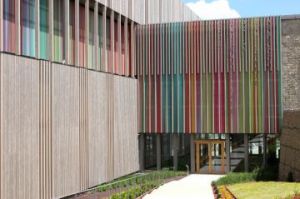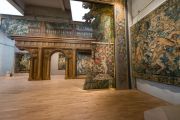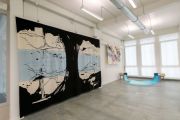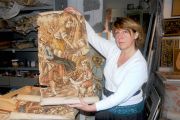 |
 |
Aubusson, a gold standard in tapestry |
 |
 |

|
 Cité de la Tapisserie © DR Cité de la Tapisserie © DR

|
Since centuries, some of the world finest tapestries are produced in Aubusson. About twenty workshops and manufactures perpetuate this traditional know-how and the Cité de la tapisserie’s museum recounts the evolution of the production.
[ Practical ]
Getting there
- By road
400 km from Paris on autoroutes A6b, A10, A71and A714 till exit 43 then on D997, D40 and D990a till Aubusson.
- By train
Intercités train from Paris Austerlitz to La Souterraine then bus from La Souterraine to Aubusson. The journey takes around 4 h 20 mn.
Lodging
- Hotels
Les Maisons du Pont
La Beauze
Le France
Le Chapitre
Au Petit Vatel, in Moutier-Rozeille, 6km away
-Bed and breakfast
L'Entresort
La P'tite Maison
Restaurants
Le France
Le Lion d’Or
Au Petit Vatel
Cité Internationale de la Tapisserie
Rue Williams-Dumazet, 23200 Aubusson
Open every day except Tuesday from 9.30am to noon and from 2pm to 6pm from September to June, from 10am to 6pm and Tuesday from 2pm to 6pm in July and August. Closed in January.
Admission : €7 / €5
Tel : 0555630830
www.cite-tapisserie.fr
Musée des Cartons de Tapisserie
Pont de la Terrade
Open Tuesday and Saturday from 3pm to 6pm from November to March, Tuesday to Saturday from 2pm to 6pm from April to October.
Admission : €5 / €2
Tel : 0688253507
atelier-musee.wixsite.com/amcarta
Maison du Tapissier
Rue Vieille
Open Monday to Saturday from 10am to noon from November to March, Monday to Saturday from 9.30am to 12.30pm and from 2pm to 6pm as well as Sunday from 10am to noon and from 2.30pm to 5.30pm from April to October
Admission : €5
Tel : 0555663212
Manufactures
- Manufacture Saint-Jean
3 rue Saint Jean
Open to visit from Monday to Friday from 9am to noon and from 2pm to 5pm. Saturday and Sunday from 2 to 5pm except during winter.
Admission : €10
Tel : 0555661008
www.manufacture-saint-jean.fr
- Manufacture Pinton
9 rue Préville, in Felletin
Tel : 0555665542
Guided tours organized by Felletin Tourist Office on Tuesday and Thursday at 10.30am from April to October.
Admission : €4.50 / €2
Tel : 0555665460
www.felletin-tourisme.fr
Information
- Aubusson Tourist Office
Tel : 0555663212
www.tourisme-aubusson.com
- Limousin Tourist Office
Tel : 0555110590
www.tourismelimousin.com
- Creuse Tourist Office
Tel : 0555519323
www.tourismecreuse.com
The name Aubusson probably rings a bell to you especially if you take an interest in interior decoration and textile arts. It’s indeed one of the world most famous tapestry centres, to the extent that Aubusson has become a common noun in some languages. Another proof of its fame, in 2009 it was added to the UNESCO Intangible Cultural Heritage of Humanity.
 One-off pieces One-off pieces
A small town of 4 000 inhabitants in the centre of France, nestled along the Creuse river and surrounded by wooded hills where stand the remains of a medieval fortress, Aubusson still counts about twenty manufactures and workshops perpetuating this traditional know-how dating back to the 15th century and some are open to the public. Using horizontal looms (low-warp) and working on the reverse side of the tapestry, weavers exclusively produce made-to-order and hand made one-off pieces following cartoons created by designers. Depending on the complexity of the pattern, it takes them between one and half and two month to make one square meter. Hence the price of Aubusson tapestries that ranges from €4 000 to €5 000 par square meter.
To learn more about it pay a visit to the Cité de la Tapisserie inaugurated in the summer of 2016 and easily recognizable with its walls covered with stripes of wood and textiles of different colors.

 Cité de la Tapisserie © Eric Roger Cité de la Tapisserie © Eric Roger
|
 City of Tapestry City of Tapestry
Containing works from the 15th century to the present day, its museum shows the evolution of tapestry and provides explanations on the manufacturing techniques as well as on the materials used. The visit begins with a room dedicated to tapestries from all over the world. Then, a large nave allowing the hanging of works of great sizes presents in a chronological order tapestries produced in Aubusson with a scenography recalling the time of their creation. Two periods are highlighted. The golden age of Aubusson, between the 15th and 18th centuries with mille-fleurs style, verdure and narrative tapestries. The revival of the 20th century, with creations by cartoonist painters such as Marc Saint-Saëns and artist tapestries by Jean Arp, Le Corbusier, Vasarely, Braque, Man Ray and so on. Besides, another room evokes the weavers of Aubusson, the techniques they use and their know-how through objects, iconographic documents and audio-visual materials.

 Cité de la Tapisserie © Eric Roger Cité de la Tapisserie © Eric Roger
|
 Uncertain origins Uncertain origins
The visit ends with an area dedicated to contemporary creation as the Cité objective is also to train new weavers, promote the Aubusson tapestry and support contemporary creation. For this purpose it organizes every year a competition open to worldwide artists, purchases the works of the three winners and add them to its permanent collection.
How did tapestry production begin in this region ?.. Was it introduced by Flemish weavers un the 15th century ?.. By Arabs who sought refuge and settled in the area after they were defeated by Charles Martel in Poitiers in 732 ?.... Nobody knows for certain although the first hypothesis is the most likely one. But, what is sure is that weavers chose this spot because of the purity of the waters of the Creuse river and of the abundance of high quality wool as many sheep were once raised in the region.
 Royal Manufacture Royal Manufacture
Another certainty, first weavers settled in Felletin, a dozen km away, and not in Aubusson.
But most people only know the name of the latest although both towns were given the status of Royal Manufacture by Colbert In 1665 and 1669. However, production has been always carried out by individual workshops maintaining independence and freedom of management. In the 17th and 18th centuries, they enjoyed a remarkable expansion producing tapestry depicting verdure sceneries and landscapes, then gallant and pastoral scenes as well as chinoiserie, a genre fantasy set in China and the Orient.
A down turn in fortunes came in the 19th century after the arrival of wallpaper and a decline in the quality of the production restricted to copies of existing paintings.
Fortunately, tapestry enjoyed a revival in the 20s and 30s thanks to two persons.

 Dom Robert's tapestry © Thierry Joly Dom Robert's tapestry © Thierry Joly
|
 20th century revival 20th century revival
Marie Cuttoli, a textile businesswoman, a collector and a patron of arts who convinced great artists such as Cocteau, Dufy, Dali Braque, Calder, Picasso to allow some of their canvases to be copied on tapestry and then invited them to create original works to express themselves through the medium of wool. Painter and tapestry designer Jean Lurçat who formulated the basic principles that were to make tapestry an art form in its own right and rediscovered the coarser texture and bolder if more limited color palette that characterized original medieval tapestries.
In his wake, a young generation of contemporary painters and artists took over and worked with Aubusson workshops. The most famous is Dom Robert, a Benedictine monk whose works are inspired by European and Persian medieval manuscript miniature paintings.

 Chantal Chirac © Thierry Joly Chantal Chirac © Thierry Joly
|
 Tapestry cartoons Tapestry cartoons
If you want to know more about the subjects and patterns woven in the past, go to visit the Musée des Cartons created by Chantal Chirac, the only restorer of these drawings used as a guide by weavers to make the tapestries. It contains hundreds of these models, mainly 19th and 20th century gouaches copying works by famous 18th century painters such as Boucher, Watteau, Fragonard and Oudry, but also a few 18th and 79th century oil works.
The museum and the workshop occupy a beautiful ancient house located along the river in the picturesque medieval district of Terrade. A maze of small streets, passageways and staircases, it was there once lived the dyers and the weavers. An old stone bridge connects its with the town centre that boasts several buildings worth a look. The Sainte-Croix church, built in the 13th century, the Clock Tower, a former watching tower of the ramparts, as well as several fountains and wealthy houses built in the Renaissance period.
 Renaissance houses Renaissance houses
The most beautiful is the Maison du Tapissier, once owned by a dynasty of tapestry makers, the Corneille. Turned into a small museum containing antique furniture, tapestries, an horizontal loom as well as reconstructions of a cartoon painter workshop and a tapestry seller’s office, it tells the history and traditions of tapestry.
If you have time, go to Felletin, where it all began. For this village not only boasts a few weaver workshops but also an architectural heritage bearing witness to its former prosperity : remains of fortifications, beautiful fountains, houses with turrets from the Renaissance, and several religious buildings. The most interesting is the 12th century Moutier church that is decorated with superb wall paintings including some made by weavers from the local manufactures.
December 30, 2016
Thierry Joly 

|
|
 |

|
 |



